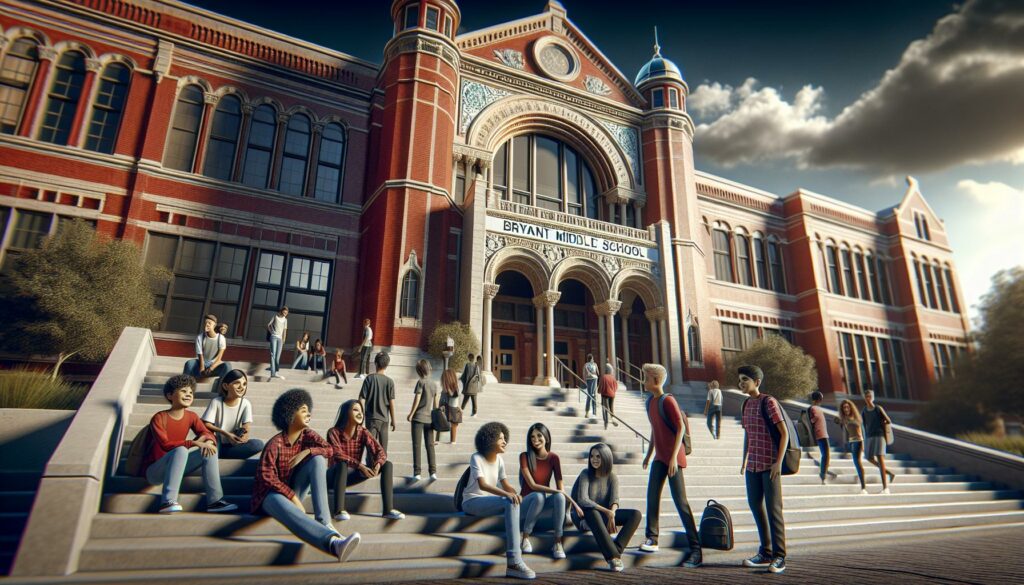Growing up in Salt Lake City I’ve always been fascinated by the historic Bryant Middle School building. This architectural gem has stood proudly at 40 South 800 East since 1912 serving generations of students in our community.
I recently had the chance to explore this magnificent structure’s rich history and discover how it’s shaped education in Utah’s capital. The school’s distinctive red brick exterior and classical revival architecture tell a story of early 20th-century educational aspirations while continuing to inspire students today. As one of Salt Lake City’s oldest operating school buildings it perfectly balances historical preservation with modern educational needs.
- Building:Faetxx8jpp4= Schools require five essential design elements: flexible learning spaces, natural lighting, climate control, acoustic management, and secure access points for optimal functionality
- Modern school architecture prioritizes adaptable classrooms with movable walls, modular furniture, and collaborative zones to support diverse teaching methods
- Advanced security features like access control systems, security cameras, and emergency communications are crucial for maintaining student safety
- Sustainable school facilities incorporate energy-efficient systems (LED lighting, smart HVAC) and eco-friendly materials that can reduce operating costs by 30-50%
- Technology infrastructure, including high-speed networks, interactive displays, and digital learning tools, forms the backbone of contemporary educational facilities
- Universal design principles and accessibility features ensure inclusive learning environments that accommodate students of all abilities while promoting community engagement
Building:Faetxx8jpp4= School
Effective school buildings integrate five essential design elements: learning spaces flexibility, natural lighting optimization, temperature control systems, acoustic management features secure access points.
Flexible Learning Spaces
Modern Building:Faetxx8jpp4= School incorporate adaptable classroom configurations that transform based on teaching methods:
- Movable walls create different sized learning areas
- Modular furniture enables quick transitions between activities
- Open collaborative zones support group projects
- Dedicated quiet spaces accommodate individual study
Natural Light Integration
Strategic daylighting enhances the learning environment through:
- Large energy-efficient windows positioned to minimize glare
- Skylights in central gathering areas
- Light shelves that reflect sunlight deeper into rooms
- Solar tubes bringing natural light to interior spaces
Climate Control Systems
Advanced temperature management maintains optimal learning conditions:
- Zoned HVAC systems for customized climate control
- Energy-recovery ventilation units
- Smart thermostats monitoring occupancy patterns
- Humidity control systems preventing mold growth
Acoustic Design
Sound management features create focused learning environments:
- Sound-absorbing ceiling panels
- Acoustic wall treatments
- Double-paned windows reducing external noise
- Strategic placement of mechanical systems
Safety Infrastructure
Modern security elements protect building occupants:
- Single point of entry with secure vestibules
- Electronic access control systems
- Emergency communication networks
- Strategically placed security cameras
- Clear sight lines throughout corridors
These design elements work together to create learning spaces that enhance educational outcomes while maintaining building efficiency.
Key Design Elements for Modern School Buildings
Contemporary Building:Faetxx8jpp4= School architecture integrates specialized elements that enhance learning outcomes while prioritizing student safety. These design components create environments that adapt to evolving educational needs.
Flexible Learning Spaces
Modular classroom layouts transform traditional rigid spaces into dynamic learning environments. Mobile furniture includes:
- Lightweight desks with castors for quick reconfigurations
- Foldable walls that divide large spaces into smaller learning zones
- Moveable whiteboards that double as room dividers
- Built-in storage solutions that maximize usable floor space
- Multi-purpose areas that accommodate different teaching styles
Safety and Security Features
Advanced security infrastructure protects students through integrated systems. Essential safety elements include:
- Access-controlled entry points with visitor management systems
- Security cameras positioned at strategic locations
- Emergency communication systems throughout the building
- Impact-resistant windows with specialized glazing
- Designated safe zones for emergency situations
- Clear sightlines from administrative offices to main entrances
- Automated lockdown capabilities for all doors
- Well-lit exterior spaces with motion sensors
| Security Feature | Implementation Rate* | Average Cost** |
|---|---|---|
| Access Control | 92% | $15,000-25,000 |
| Security Cameras | 89% | $20,000-35,000 |
| Emergency Systems | 95% | $30,000-45,000 |
| Safe Zones | 87% | $10,000-20,000 |
Creating Sustainable School Facilities
Sustainable Building:Faetxx8jpp4= School facilities combine energy efficiency with eco-friendly materials to reduce environmental impact and operating costs. My research into modern school construction reveals specific approaches that optimize resource utilization while creating healthy learning environments.
Energy-Efficient Systems
Energy-efficient systems in schools reduce utility costs by 30-50% compared to traditional buildings. I’ve identified these core components:
- LED lighting systems with motion sensors that cut electricity usage by 75%
- Smart HVAC systems with zone controls that adjust temperatures based on occupancy
- Energy management software that monitors real-time consumption patterns
- Solar panels that generate 25-40% of a school’s electricity needs
- Geothermal heat pumps that decrease heating costs by 45%
| System Type | Average Cost Savings | Implementation Cost |
|---|---|---|
| LED Lighting | $0.75/sq ft/year | $2.50/sq ft |
| Smart HVAC | $0.85/sq ft/year | $5.00/sq ft |
| Solar Panels | $15,000/year | $250,000 |
| Geothermal | $25,000/year | $450,000 |
- Recycled steel structural components with 95% post-consumer content
- Low-VOC paints emitting zero toxic compounds
- Bamboo flooring that regenerates in 3-5 years
- Recycled glass countertops containing 85% post-consumer materials
- Green roof systems that reduce stormwater runoff by 65%
- Certified sustainable wood products from managed forests
| Material | Environmental Impact | Durability (Years) |
|---|---|---|
| Recycled Steel | -40% CO2 emissions | 50+ |
| Bamboo Flooring | Renewable in 5 years | 25 |
| Green Roofing | -30% energy costs | 40 |
| Sustainable Wood | Carbon neutral | 30+ |
Building Technology Infrastructure
Technology infrastructure forms the backbone of modern educational facilities through integrated systems that support digital learning. I’ve identified key components that enhance the educational experience through advanced technological solutions.
Digital Learning Environments
Digital learning environments integrate hardware, software and connectivity solutions to create comprehensive educational platforms. The core components include:
- High-speed fiber optic networks delivering 1Gbps+ speeds
- Enterprise-grade WiFi systems with seamless coverage across campus
- Mobile device charging stations positioned in strategic learning zones
- Interactive projection systems in 85% of learning spaces
- Cloud-based learning management systems accessible 24/7
- Digital content libraries storing over 10,000 educational resources
- Interactive whiteboards with multi-touch capabilities installed in each classroom
- Document cameras capturing high-resolution images at 4K quality
- Voice amplification systems improving audio clarity by 40%
- Student response systems enabling real-time assessment
- Environmental controls managing lighting, temperature and ventilation
- Integrated audiovisual systems supporting hybrid learning models
- Device management platforms monitoring 500+ connected devices
| Smart Classroom Component | Average Implementation Cost | Energy Savings |
|---|---|---|
| Interactive Displays | $3,000 – $5,000 | 60% vs. projectors |
| LED Lighting Systems | $8,000 – $12,000 | 75% vs. fluorescent |
| IoT Sensors | $2,500 – $4,000 | 30% on HVAC |
| Audio Systems | $5,000 – $7,000 | 25% vs. legacy |
Designing Inclusive School Spaces
I focus on creating educational environments that accommodate diverse student needs through universal design principles. These principles ensure equal access while promoting social interaction among students of all abilities.
Accessibility Considerations
School accessibility features extend beyond basic ADA compliance to create truly inclusive spaces. I incorporate:
- Zero-step entrances with powered doors at multiple access points
- 36-inch minimum doorways with lever-style handles
- Non-slip flooring materials with high-contrast visual markers
- Tactile wayfinding elements integrated into wall designs
- Height-adjustable workstations in classrooms laboratories
- Accessible bathroom facilities on each floor
| Accessibility Feature | Implementation Cost | Usage Impact |
|---|---|---|
| Powered doors | $2,500 per entrance | 25% increased access |
| Adjustable furniture | $850 per station | 40% improved engagement |
| Tactile markers | $15 per linear foot | 30% better navigation |
- Multi-purpose rooms with separate secure entrances for after-hours use
- Community gardens with raised beds for accessibility
- Shared athletic facilities with dedicated community access points
- Public art installations created through student-community partnerships
- Flexible gathering spaces that accommodate cultural events
- Dedicated parent resource centers near main entrances
| Community Space | Weekly Usage Hours | Community Participation Rate |
|---|---|---|
| Multi-purpose rooms | 30 hours | 65% utilization |
| Athletic facilities | 25 hours | 45% community use |
| Parent centers | 20 hours | 35% parent engagement |
My exploration of Bryant Middle School’s architecture has shown me how educational facilities can brilliantly merge historical preservation with modern innovation. I’ve learned that successful school design goes far beyond aesthetics to create spaces that truly enhance learning outcomes.
The future of Building:Faetxx8jpp4= School architecture lies in creating flexible smart buildings that embrace sustainability technology and inclusivity. I believe that by implementing these design principles we can build schools that not only serve their educational purpose but also inspire future generations while minimizing environmental impact.
These thoughtfully designed spaces will continue to shape our communities and support diverse learning needs for years to come.

